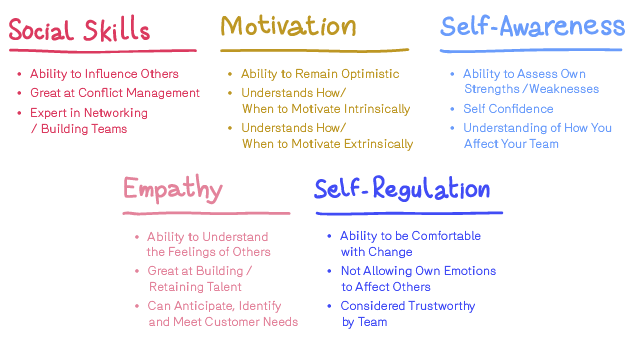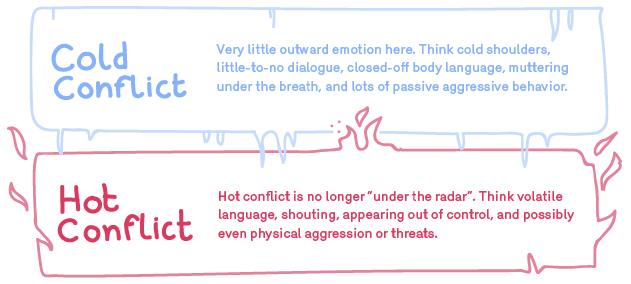— April 13, 2018

Conflict is a natural part of working in teams. But not a fun one. As a leader, it’s your job to guide a diverse group of people with different skills, motivations, and personalities toward a common goal. Except it’s not just their workflow you end up managing – it’s also their emotions.
Unsurprisingly, dealing with conflict between employees is a stumbling block that trips up managers of all experience levels every day.
What’s more – it’s only one of the many situations where pure intellect and technical expertise aren’t going to do you much good.
Enter Emotional Intelligence (also known as IQ’s counterpart, EQ), a key skill-set that’s increasingly being recognized as the main ingredient in successful leaders. Similar to how IQ represents the measure of a person’s intelligence, EQ gauges the understanding of one’s own emotions, as well as those of the people around them.
EQ breaks down into five domains: Self-Awareness, Self-Regulation, Motivation, Empathy, and Social Skills. Each of them helps you in different, vital ways to deal with people, relationships and situations in your role as a manager.
And the best part? They can all be learned – we promise.
Our goal today is to get you started on the path to building or improving your level of emotional intelligence with a specific focus on its use in conflict resolution. We’ll go over some useful strategies and approaches that should set you up to deal with conflict on your team in a meaningful and long-lasting way.
Improve Your Social Skills, Improve Your Conflict Management Skills
The five domains of emotional intelligence cover a lot of ground. To make sure you get the most out of our content, we’ll look at them individually and narrow down the focus of each to target scenarios our community most commonly asks for advice on. Near the very top of that list: conflict resolution in the workplace – specifically between two team members.

According to Daniel Goleman who (literally) wrote the book on emotional intelligence, when it comes to conflict resolution, managers with strong Social Skills will always have an edge.
“Socially skilled people tend to have […] a knack for finding common ground with people of all kinds – a knack for building rapport. It’s not just a matter of friendliness. Social skill, rather, is friendliness with a purpose: moving people in the direction you desire…”
– Daniel Goleman
Considering two hallmarks of Goleman’s Social Skills domain are the ability to influence people, and the ability to find common ground with almost anyone, it’s little surprise that managers who are strong in these areas also make for strong mediators.
Below we’ll dive into some of the most effective ways a manager can deal with conflict on their team. It should be noted that the sharper your Social Skills and overall EQ, the more easily you’ll be able to put these techniques into practice.
If you’re looking to develop those Social Skills and become a conflict manager by building on what you learn in this post, keep an eye out for our free Emotional Intelligence Email Course, out next week. Designed by experts, each of the five lessons cover a different domain, how you can apply it in your day-to-day, and provides guides, templates, additional resources & exercises that you can start putting to use immediately.
Now let’s get into some strategies and specifics.
How to Minimize Conflict on Your Team
The key word here is “minimize”. In fact, that brings us to our Golden Rule of Conflict Management – one of the most universal pieces of advice you’ll find on the subject, and also the simplest.

Any reputable source will tell you, like breathing, conflict is just a part of life. Not every member of your team is always going to get along and it’s crucial you accept this. Sometimes problems simply need to surface before we can move past them. For that reason, it’s best to frame conflict as an opportunity – for the employees involved in it, for your team as a whole, and also for yourself.
Proactively addressing conflict head-on, gives your team the chance to prove to themselves – and each other – that they can overcome differences while strengthening themselves as a unit at the same time. As their manager, you gain experience in the wonderfully uncomfortable process of identifying, understanding, and resolving conflict. And that’ll make it just a little bit easier the next time. And the time after that.
With that out of the way, here are a few things you can do to minimize conflict before it starts, while laying the groundwork for easier resolution later.
Set Clear Expectations, Define Acceptable Behavior
Whether you’re trying to hit the “reset” button with your existing team or inheriting a new one and looking to start on right foot, it’s never a bad idea to lay down some pre-existing ground rules to help define acceptable and unacceptable behavior.
While it may seem obvious, explicitly stating that behaviors such as yelling, rudeness, bullying, shunning, etc. are simply unacceptable and will not be tolerated, may help an employee think twice before getting carried away. The more you can influence your team to identify with a culture of respect, the easier it will be for them to productively iron out their own wrinkles.
Forbes suggests that the majority of conflict in the workplace stems from two main issues – poor communication, and poor control of one’s emotions. An employee’s emotions are obviously beyond your control, but how your team communicates isn’t, so start there:
“If you reflect back upon conflicts you have encountered over the years, you quickly recognize many of them resulted from a lack of information, poor information, no information, or misinformation.”
To avoid the same pitfalls, make effective communication easier from the start by laying down a clear framework. Establish a foundation of respect by crystalizing the roles of every team member for the group. Underline the value they each bring to the table in achieving your mutual goal, and make your personal respect for every role clear.
Outlining expectations, swim lanes, chain of command, and laying out clear procedures for how to flag and address conflict early can often help nip problems in the bud before they can escalate.
It’s also on you as manager to keep your eyes peeled for potential conflict areas, so you can step in as soon as there’s smoke. Catching and dealing with these moments quickly, and in a fair and diplomatic way has a big effect on preventing certain conflicts altogether, while reducing the severity of the ones that do crop up.
3 Questions to Help Understand and Resolve Any Conflict
Acknowledging that a conflict is taking place on your team is one thing. Understanding who the participants are and the root of the conflict itself is another thing altogether.
There are a million different reasons an argument might take place. While you’ll probably never know all the details, it’s still your job to get the lay of the land so you can decide how to deal with each situation.
Start by trying to better understand the conflict by asking yourself these three questions:
Is the Conflict Hot or Cold?
The Harvard Business Review categorizes conflict you’d likely encounter in the workplace under two banners:

As HBR states, once you’ve identified the type of conflict your dealing with, it’s the manager’s role to step in, take control of the thermostat, and find the sweet-spot:
“Conflicts that are warm – that is, already open for discussion but not inflamed with intense hostility – are far more likely to be productive. So, if you’re dealing with cold conflict, you need the skills to ‘warm it up’. If you’re dealing with hot conflict, you need the skills to ‘cool it down’.”
Cooling Down a Hot Conflict
Bringing two people together who are embroiled in a heated conflict can be dicey. If the conflict is too hot at the time, don’t be afraid to let things cool down a little before attempting to resolve it.
Once things have cooled, try setting clear and concise ground rules that each participant must agree on ahead of time. These can include everything from setting three-minute time limits on each person’s speaking-turns, or getting them to come to the table each with a suggestion already in mind on a mutually beneficial way to move forward.
You can also put those Social Skills to the test and try to defuse some of the aggression by finding the common ground between participants. Open with a question about how stress at work has personally affected each of them over the past month to humanize their situations, get them relating, and on the same page.
Warming Up a Cold Conflict
While it’s usually easier to bring these two parties together, the focus once you do will be on starting a constructive dialogue between them in which they both participate.
The goal here is to get them talking as you lead the conversation. It’s also worth noting that cold conflicts typically involve a lot of repressed emotions. As the conflict warms and those emotions start surfacing, you’ll want to keep an eye on the temperature to make sure it doesn’t overheat as feelings begin pouring out.
What are the Conflict Styles of the Employees Involved?
While conflicts can be seen as hot or cold, so too can an individual’s approach to conflict. The ways in which a conflict – and its resolution – play out have a lot to do with whether the people involved are conflict avoiders, or conflict seekers.
As a manager, it’s your job to observe and know your team so you can more easily generate a game-plan if conflict arises. Understanding whether the stakeholders are avoiders (uncomfortable butting heads with coworkers) or seekers (willing or eager to engage in disagreements) can give you a window into how the conflict might play out, and the different strategies you can employ to help solve it.
The Harvard Business Review offers some great insights in their breakdown of avoider/seeker combinations and how to approach each one.

Problem:
- No one addresses the issue
- Suppressed feelings that explode later
Solution:
- You’ll need to take the lead
- Take a sensitive approach to the situation
- Don’t let them shy away from the problem

Problem:
- No one holds back
- Discussion can get heated quickly
- Each could feel disrespected
Solution:
- Suggest they both prepare for the conversation
- Be ready to take breaks if things get heated
- Shift to a neutral setting – getting a coffee / taking a walk

Problem:
- The Seeker may bulldoze the Avoider
- The Avoider may respond with a passive aggressive approach
- The Avoider may agree too easily with what the Seeker wants
Solution:
- Ask the Avoider to be honest, participate, and not hide their opinions
- Explain to the Seeker in advance that you expect a calm demeanor and tone during the conversation
- Encourage the Avoider to be direct and to the point
- Encourage the Seeker to be patient should the pace of the conversation slow.
How Can I Focus on the Problem, Not the People?
Once you have a clearer idea of the temperature of the conflict and the conflict styles of the people involved, it’s time to shift your focus toward understanding the problem.
There’s a good chance that the incident you’ve just walked into the middle of isn’t even representative of the real conflict. In fact, the source of the real conflict might be something that occurred over a month back, but left unresolved was allowed to fester as bickering continued, got more personal, and stress levels rose.
So, before you assume the conflict you’re dealing with is actually about a team member ‘typing and breathing too loudly’, ask questions like, “When do you think the problem between you two first started?” and work to reveal the root of the issue, so you can best resolve it.
6 Surprisingly Effective Conflict Management Strategies
Now that you have a better idea how to consider and approach conflicts, let’s add a few more tactics to your arsenal for resolving them.
Every conflict is unique and what works for one may not work for the other, so flex those social skills, understand where each stakeholder is coming from, and work to influence a positive change over the situation.
-
Encourage Active Listening
If you’re mediating a conflict between two employees, you’re going to need them to empathize with each other on some level before resolution becomes reality.
In advance of sitting them down, encourage each to brush up on the finer points of active listening so they can come prepared. Active listening is all about really opening yourself up to what another person is saying, and not just waiting for your turn to talk – which most of us do.
Active listening involves giving the other person the chance to express their opinion, having the control to not react impulsively to anything that’s said, and repeating back each other’s main points as a show that statements have honestly been heard, and more importantly understood.
Check out this article from Fast Company for more on active listing basics.
-
Change the Scenery

Sometimes a simple change of scenery can go a long way. Since the conflict started in the workplace, a little separation from the setting can often calm the nerves and get conversation flowing.
If based on the stakeholders, you believe there’s an opportunity for them to resolve things on their own, suggest they grab lunch together at a restaurant away from the office. If you think the situation needs a third party, join them. A more relaxed backdrop will probably help things feel less formal, and ideally more social and friendly. Put the bill on the company dime if possible and help show that the effort they’re putting in is appreciated.
-
Get the Whole Team Involved
As Forbes points out, sometimes a conflict between two people has the potential to pull others into its wake and create divisions within your team as a whole.
If that’s the case, don’t be afraid to counter this by having the resolution come from the team itself. Positively dealing with conflict is often what leads to team-wide improvement, so implicate everyone and get them invested in brainstorming a solution that will help them work better together as a unit, while also avoiding similar conflicts in the future.
Conflict solutions that come of out a team brainstorm often also have a better chance at sticking, since everyone was aware, present, in agreement, and therefore on the hook for honoring the resolution.
-
Get Commitment for Realistic Change
The best resolutions tend to be the ones that come from the stakeholders themselves. Conversations can take place, and opinions can be communicated, but unless the two parties can commit to making certain changes, there’s a good chance the conflict will flare up again.
Have each participant (or the whole team depending on the situation) come to the table with a few concrete ideas each on how to positively move the issue forward.
While you may have to help shape these ideas as they emerge, Fast Company suggests trying to make the solutions process-related (we need a better way to make sure everyone is heard) vs. personal (Janet needs to do a better job of speaking up), which helps also make them more easily actionable.
At the same time, get the stakeholders to agree on a maximum of three of these actions to create change that’s realistic, attainable, and not overwhelming.
-
Shake Things Up
Sometimes, it’s good to accept that things won’t always work out the way we want them to. Maybe you’ve tried everything on this list. Maybe you found another list and tried that too. But the change you’re looking for just isn’t materializing.
In these moments, it’s important to appreciate that you could be doing all the right things, but some people just weren’t meant to work together. If you’ve come at the conflict head-on and run into a wall every time, the moment for expending more resources, energy, and time may be over. Consider exploring possibilities of reassigning a team member elsewhere within your organization if you truly believe it may be a better fit for them, and for the rest of the group.
-
Partner with HR
As a manager, working out conflict within your team should generally be your aim. You’re the closest to them and you probably understand them, their grievances, and motivations better than an outside third party.
But there are times when everyone can benefit from a little backup, and connecting with HR, whether for advice or intervention can be exactly what the situation requires. Start out by using them as a sounding board to get an objective opinion since you might be too close to the conflict to see it from a certain angle. And if the employee conflict is particularly difficult, don’t be afraid to hand over the reins, or agree to tackle it together. You may even learn a different approach for the future!
Have a Conflict Management Style That Works for You? Share Your Story Below!
Business & Finance Articles on Business 2 Community
(184)








